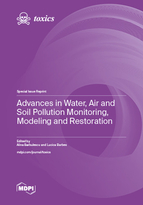Advances in Water, Air and Soil Pollution Monitoring, Modeling and Restoration
A special issue of Toxics (ISSN 2305-6304). This special issue belongs to the section "Ecotoxicology".
Deadline for manuscript submissions: closed (31 October 2023) | Viewed by 16427
Special Issue Editors
Interests: hydrology; time series analysis; applied statistics; mathematical modeling
Special Issues, Collections and Topics in MDPI journals
Interests: advanced methods and monitoring techniques of water, air and soil; analysis of organic and inorganic compounds in atmosphere, drinking water, wastewater, sewage and soil (including toxic species); bioremediation and ecosystem restoration models
Special Issues, Collections and Topics in MDPI journals
Special Issue Information
Dear Colleagues,
The pollution of air, water, and soil with different materials, chemical products, and constantly increasing amounts of waste is a global issue. It is also considered that biodegradation in the environment occurs after or simultaneously with physical and chemical degradation, which modifies the pollutants’ structure to the molecular level, generating more and more waste through increasingly complex processes to control. Currently, there are only exceptions regarding, for example, pollution with plastic materials, antibiotics, fertilizers, etc. and the study of colonizing microorganisms, biodegradation processes, and the toxic effects of these materials or chemical products on terrestrial biota and implicitly on health of human being of great interest.
Therefore, the purpose of this special issue on "Advances in Water, Air and Soil Pollution Monitoring, Modeling and Restoration" is to assess the air, water and soil pollution by different evaluation methods and to apply the findings for possible mitigation measures. The articles selected for this special issue will provide an overview of the actual research stage in the field, aiming to assess the risks and impact on the environment.
Besides the solutions to the practical problems of cleaning the water, air and soil, the selected topics will directly answer questions related to selecting different tools that best emphasize the environmental quality changes and their impact on society's future.
We look forward to receiving your contributions.
Prof. Dr. Alina Barbulescu
Dr. Lucica Barbes
Guest Editors
Manuscript Submission Information
Manuscripts should be submitted online at www.mdpi.com by registering and logging in to this website. Once you are registered, click here to go to the submission form. Manuscripts can be submitted until the deadline. All submissions that pass pre-check are peer-reviewed. Accepted papers will be published continuously in the journal (as soon as accepted) and will be listed together on the special issue website. Research articles, review articles as well as short communications are invited. For planned papers, a title and short abstract (about 100 words) can be sent to the Editorial Office for announcement on this website.
Submitted manuscripts should not have been published previously, nor be under consideration for publication elsewhere (except conference proceedings papers). All manuscripts are thoroughly refereed through a single-blind peer-review process. A guide for authors and other relevant information for submission of manuscripts is available on the Instructions for Authors page. Toxics is an international peer-reviewed open access monthly journal published by MDPI.
Please visit the Instructions for Authors page before submitting a manuscript. The Article Processing Charge (APC) for publication in this open access journal is 2600 CHF (Swiss Francs). Submitted papers should be well formatted and use good English. Authors may use MDPI's English editing service prior to publication or during author revisions.
Keywords
- atmospheric pollution control engineering and human health
- water & wastewater treatment engineering and ecotoxicity evaluation
- toxicological evaluation of on marine species
- pollution impact assessments on costal areas
- environmental impact and risk assessement
- modeling the pollutants’ dissipation and transport








